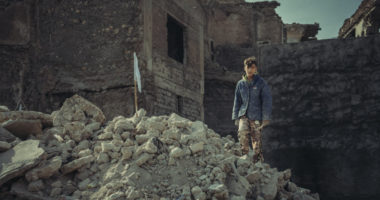Everything we know about nuclear weapons, including the new information and analysis that has come to light in recent years, has only strengthened ICRC’s conclusion that ‘it is difficult to envisage how nuclear weapons could be compatible with the requirements of international humanitarian law’. On the 20th anniversary of the International Court of Justice’s advisory opinion, ICRC Senior Legal Adviser, Louis Maresca, looks back at this notable decision and reflects on its contemporary significance. The occasion also marks the launch of a new edition of the International Review of the Red Cross on The human cost of nuclear weapons.
***
Today, 8 July 2016, marks the 20th anniversary of the release of the International Court of Justice’s (ICJ) advisory opinion on the legality of nuclear weapons. The decision itself is notable for many reasons. One of them is the extent to which it delved into and assessed customary rules of international humanitarian law (IHL) and their implications for the use or threat of use of nuclear weapons. This decision marked the first, and indeed last time to date, that the ICJ considered IHL rules on the conduct of hostilities in such detail.
As many who have read the decision will know, the Court unanimously ruled that the use of nuclear weapons must be compatible with the principles and rules of IHL. Yet its specific application of those rules to nuclear weapons was much more controversial. In a split 7 to 7 decision, with the President casting the deciding vote, the Court concluded ‘that the threat or use of nuclear weapons would generally be contrary to the rules of international law applicable in armed conflict, and in particular the principles and rules of humanitarian law […]’, but that it could not “conclude definitively whether the threat or use of nuclear weapons would be lawful or unlawful in an extreme circumstance of self-defence, in which the very survival of a State would be at stake.”
The Court’s rationale and findings have been assessed by many commentators in the years since its release. The purpose of this post is not to revisit the finer legal points of the Court’s decision and analysis. Rather, it will offer a few general comments and observations on the decision and several of the issues which rose form it and that are still relevant today.
The Court’s views on nuclear weapons and IHL
Much is often made of the fact that the Court’s conclusion on nuclear weapon use and IHL was split. To those who have not read the opinion, this often gives the impression that the ICJ was divided on the legality of nuclear weapons. But this divide is somewhat misleading as there was, in fact, broader agreement among the judges that the use of nuclear weapons could be difficult to reconcile with IHL rules. Clearly, the 7 judges who voted in favor of the Court’s conclusions on this point held that position. Yet, 2 of the 7 dissenting judges (namely Judges Weeramantry and Koroma) voted against this part of the Court’s opinion because they felt that it did not go far enough. In their view, the Court should have unambiguously concluded that the use of nuclear weapons would be unlawful in all circumstances.
In addition, although he rejected the idea that nuclear weapons were inherently indiscriminate, Judge Schwebel noted in his dissent that the Court’s conclusion that the use of nuclear weapons would be generally contrary to IHL rules “while imprecise, is not unreasonable.” He went on to say that ‘[t]he use of nuclear weapons is […], exceptionally difficult to reconcile with the rules of international law applicable in armed conflict, particularly the principles and rules of IHL’. He noted, however, that nuclear weapons may not always offend IHL rules but that an assessment must be made on a case by case basis. The remaining dissenting judges did not offer any specific views on the legality of nuclear weapons but objected to the Court’s assessment and conclusions on procedural or other grounds.
Thus, although views were divided, a clear majority of the Court shared serious reservations about whether nuclear weapon use could be consistent with IHL.
The evolution of customary law
In its ruling the Court assessed nuclear weapons against ‘cardinal principles […] constituting the fabric of humanitarian law’. These were elaborated as: (a) the principle of distinction, from which flows an obligation to never make civilians the object of attack and a prohibition on the use of indiscriminate weapons, and (b) the prohibition against causing unnecessary suffering to combatants, which includes a prohibition on using weapons causing such harm or uselessly aggravating combatant suffering.
Yet, the Court also rightly noted that there are other fundamental IHL rules which are part of customary international law, such as the rules of the 1907 Hague Convention (IV) Respecting the Laws and Customs of War on Land and the 1949 Geneva Conventions. It further highlighted that, at the time of its decision, all States were bound by those provisions of 1977 Additional Protocol I (API) which, when adopted, were an expression of pre-existing customary rules. The ICJ opinion gave no indication as to which AP I provisions it was referring to. But the inference is that these too may have implications for the use of nuclear weapons. This is important because at the time of their ratification of AP I, a number of nuclear armed States and their allies submitted declarations or reservations that the IHL rules introduced by AP I were to understood to apply only to conventional arms and were not intended to regulate or prohibit the use of nuclear weapons.
Of course, customary law evolves and today there is a clearer picture of the full range of customary rules that would apply to any use of nuclear weapons. Thanks in large part to the ICRC’s study on Customary International Humanitarian Law, and the practice and opinio juris found therein, customary rules such as the rule of proportionality, the prohibition of indiscriminate attacks and the rule on feasible precautions are clearly situated as legal obligations relevant for assessing the use of nuclear weapons under IHL, even though they were not specifically mentioned or applied in the ICJ’s opinion. These rules would surely need to be part of any credible legal assessment today.
Arguments supporting the legality of nuclear weapons
A number of States argued before the Court that small, low-yield tactical nuclear weapons could be used in some circumstances in a manner consistent with IHL obligations. Most involved the use of such weapons away from civilian populations (e.g. in the desert or at sea). Yet, the Court dismissed these arguments, noting that they did not provide the precise circumstances justifying use and concluded that without this information, it did not have ‘sufficient basis for a determination on the validity of this view’.
Twenty years later, it is still the case that the arguments supporting the legality of nuclear weapons often lack the details necessary for a full legal assessment. Indeed, it is difficult to find scenarios in the public domain that specify how such weapons would be used and which include information on the intended military target, the yield of the weapons, the nature and anticipated levels of civilian and combatant casualties and suffering, the potential damage to civilian objects and the surrounding environment, including wind patterns or sea currents. While security and other national concerns may underlie the lack of information, they also hinder a full legal analysis.
There have been case studies which include some of this information, although they have tended to focus on use in or near populated areas. And these indicate that even the limited use of nuclear weapons would have significant consequences for civilians and the environment. They also show how ionizing radiation can travel significant distances and still impact on civilians away from the target area. When coupled with the range of other humanitarian consequences that would result from the use of any nuclear weapons (see the statements and chair’s summaries of the conferences on the humanitarian impact of nuclear weapons held in Oslo on 4-5 March 2013, in Nayarit on 13-14 February 2014 and in Vienna on 8-9 December), these studies have heightened rather than diminished concerns about nuclear weapons in humanitarian and legal terms.
In its comments following the ICJ’s Advisory Opinion in 1996, the ICRC concluded that it is ‘difficult to envisage how a use of nuclear weapons could be compatible with the rules of international humanitarian law’. Everything that we know about nuclear weapons and the new information and analysis that has come to light over the past 20 years has only strengthened this conclusion.
***
Read more
- The human cost of nuclear weapons – International Review of the Red Cross, No. 899.
- Nuclear weapons – International Review of the Red Cross, No. 316.






Comments